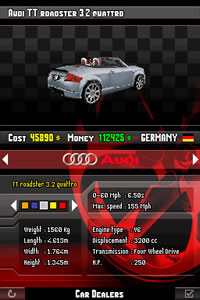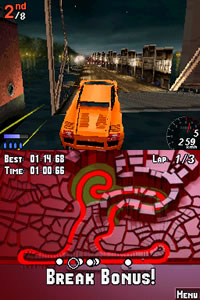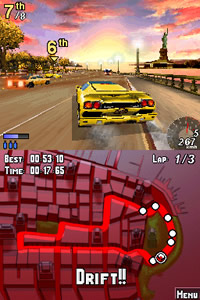A pain in the asphalt.
We tend to obsess about realism in games, but as a human being stuck living in the real world, I’d definitely like to see my reality imitate video games a lot more.
A great place to start would be with Ubisoft’s Asphalt Urban GT for the Nintendo DS.
In this reality, cars never take damage and four-hundred miles per hour head-on collisions only result in a momentary loss of velocity. If the world were more like Asphalt Urban GT, I’d be able to drive to work with my eyes closed on the wrong side of the street without ever crashing. Then again, as this game proves, a world without consequences can go from zero to tedious in no time flat.
There are quite a few modes hiding under the umbrella of Arcade, Evolution, and Multi-Card (multiplayer). The Arcade mode is actually collection of modes including Instant Play, Road Challenge, Time Attack, Free Race, and Cop Chase.
Instant Play drops you into a random car for a random race, and is the only mode that plays like its title suggests. In Road Challenge, you pick a race class such as Urban or Classic, choose a car from the selected class, and compete in a series of five races. If you finish in the top three spots, you unlock a car. Free Race is set up just like Road Challenge, except that you only compete in one race, and there is no prize…thus, no point. Time Attack, on the other hand, presents a nice change of pace as it allows you to fly around any track you desire without any competitors or traffic to deal with.
Cop Chase sounds compelling but is pretty basic, as you just pursue criminals in a fancy cop car. To “capture” them, you simply have to hang close behind them for a long enough time and they’ll pull over and out of the race. While it’s kind of nice to be on the other side of the sirens for once, you don’t get to do any of the fun stuff like take a ridiculously long time to run their license plate, needlessly call in back-up, or ask the driver how fast they thought they were going.
Evolution mode functions as the game’s career mode, a combination of a garage and a bunch of competitions that can only be accessed if you own one of the requisite vehicles. Winning usually entails a cash reward and an unlocked car, which can then be used to access locked competitions. Unfortunately, the competitions themselves lack variety, especially when you’re just starting out. The first four all involve the same three maps and the same conditions for victory. While you’ll eventually race courses backwards and engage in duels, don’t expect a lot of variety here…
…because that was saved for upgrades! There are only 9 maps and about 15 drivable cars, but there are dozens of upgrades. This is sillier than it sounds since the cars don’t have sophisticated physics or handling schemes. There aren’t any conditions or climates to take into account when tuning your car because it will handle the same regardless of the surface or the weather. All of Asphalt Urban GT‘s little tune-ups are really just bonuses that will make any car in the game go faster or handle tighter.
 Making upgrades even more useless is the fact that your car and all of its components are invincible. You’ll never have to tune anything up, because nothing will ever wear down. On top of that, Asphalt Urban GT‘s cars always look brand new, even if you treat them like crap. As much as I’d like a real, indestructible car, I actually look for the opposite in my digital rides.
Making upgrades even more useless is the fact that your car and all of its components are invincible. You’ll never have to tune anything up, because nothing will ever wear down. On top of that, Asphalt Urban GT‘s cars always look brand new, even if you treat them like crap. As much as I’d like a real, indestructible car, I actually look for the opposite in my digital rides.
The lack of damage-modeling is actually a symptom of Asphalt Urban GT‘s horrible collision scheme. Walls and cars are the only objects in the game you can collide with. There are trees, boxes, cones and other objects in the environment, but none of these have any physical presence; you just drive straight through them. In some cases the wall collisions are realistic, as clipping one will send your car spinning in an awkward direction, but if you take a jump at two-hundred miles per hour and slam into a wall, you’ll simply slide back down to the ground, unscathed.
Any object with a physical presence should be considered a brick wall, including cars. If a car stops and you run into it, it won’t budge and you won’t bounce – you’ll simply stop, too. Ramming opponents’ vehicles is useless since you can’t move them and they can’t move you, although the result is still extremely jarring and unpleasant unless you get into a head-on collision. In this case, both cars will magically spin off one another and continue on their ways, making it safer to drive on the wrong side of the street.
You always start in eighth place, gradually working your way to the front before the three laps end. Each car you pass tends to get on your six and stay there until the race is over. By the time you take the lead, all seven cars will be right on your butt. This isn’t a problem unless you screw up at all and are suddenly passed by the insane knot of cars. To make matters worse, the A.I. is extremely aggressive, constantly jamming you all around the track.
To get ahead and stay ahead, you’ll need nitrous. A nitrous meter fills while you drive, and when it reaches its limit you get a useable boost, which makes you accelerate rapidly and basically lose the ability to turn. As soon as you tap the brakes the nitrous effect will end, so you’ll want to save your boosts for good straightaways.
 Asphalt Urban GT‘s gameplay is not very interesting. You accelerate, brake and turbo. Even though you can choose between a few different transmissions, all of them are automatic. The drift mechanic is handled really well and is the game’s only satisfying accomplishment. Tapping your brakes and sliding through turns at high speeds (there’s no separate hand brake, oddly) feels like it should. It’s too bad nothing else does.
Asphalt Urban GT‘s gameplay is not very interesting. You accelerate, brake and turbo. Even though you can choose between a few different transmissions, all of them are automatic. The drift mechanic is handled really well and is the game’s only satisfying accomplishment. Tapping your brakes and sliding through turns at high speeds (there’s no separate hand brake, oddly) feels like it should. It’s too bad nothing else does.
At a glance, Asphalt Urban GT looks impressive, with nicely rendered 3D environments, ambient lighting, dust kicked up during power drifts and a smooth framerate overall. But the more you play, the more problem areas you’ll discover, such as the badly rendered oncoming traffic. It’s so hard to see, you’ll be forced to play in first-person view mode if you want to succeed.
We know the DS is capable of some nuanced sound effects, but not because we found any in Asphalt Urban GT. Every car sounds like every other and the skidding sound effect is strangely muted. The audio in general is gritty and low quality. This is a shame, because some of the music is pretty interesting and might not sound bad if it weren’t constantly eclipsed by the game’s jarring, crass sound effects.
Asphalt Urban GT tries to utilize the DS’ unique features. You can play with up to three others wirelessly, which works well enough despite the lack of any other cars. Also, the bottom screen functions as a map, and until someone puts the darn thing to better use, a map is fine with us.
Less fine are all of Asphalt Urban GT‘s missing pieces, such as manual transmission, physics, and damage-modeling. I would love to drive an indestructible car that could never, ever flip in my ordinary, everyday life, but when we play games, we like to break things. After playing some Asphalt Urban GT, you’ll just want to break your Nintendo DS.
-
Fast and smooth
-
Good powersliding
-
Bad physics
-
Few tracks
-
No damage modeling
-
Car clusters











